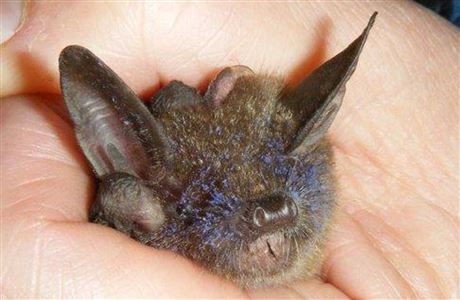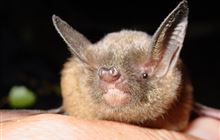Short-tailed bat
Introduction
The endangered lesser short-tailed bat is an ancient species unique to New Zealand and is found only in a few locations. The greater short-tailed bat is probably extinct.Conservation status of lesser short-tailed bat:
Southern subspecies: Threatened – Nationally Increasing
Northern subspecies: Threatened – Nationally Vulnerable
Central subspecies: At risk – Declining
Image gallery
-
Lesser short-tailed bat Image: Colin O'Donnell | DOC
![Close up of short-tailed bat. Close up of short-tailed bat.]()
-
Short-tailed bat Image: Colin O'Donnell | DOC
![Short-tailed bat Short-tailed bat]()
-
Short-tailed bat closeup Image: Graham Dainty ©
![Short-tailed bat closeup. Short-tailed bat closeup.]()
-
Short-tailed bat in flight Image: Hannah Edmonds | DOC
![Short-tailed bat in flight. Short-tailed bat in flight.]()
-
Short-tailed bat monitoring Image: Graham Dainty ©
![Short-tailed bat monitoring. Short-tailed bat monitoring.]()
-
Short-tailed bat Image: Warren Simpson ©
![Short-tailed bat. Short-tailed bat.]()
Species
There are two species of short-tailed bat.
1. Greater short-tailed bat (Mystacina robusta) was found on two islands off Stewart Island but following an invasion of ship rats, it was last sighted in 1967 and is probably extinct.
2. Lesser short-tailed bat (Mystacina tuberculata) is an endangered ancient species unique to New Zealand and is found only at a few scattered sites. It is divided into three subspecies.
- Northern lesser short-tailed bat (Mystacina tuberculata aupourica)
Found only at two sites in Northland and one on Little Barrier Island. - Central lesser short-tailed bat (Mystacina tuberculata rhyacobi)
Known from the central North Island, Taranaki and East Cape. - Southern (or South Island) lesser short-tailed bat (Mystacina tuberculata tuberculata)
Found on Whenua Hou/Codfish Island and Fiordland areas.
It is the only member of its family, Mystacinidae, known to still survive.
Facts
Short-tailed bats weigh around 12–15 g. They have large pointed ears and a free tail. They are a mousy-grey colour.
Unlike most bats, which catch their prey in the air, the short-tailed bat has adapted to ground hunting. It is one of the few bats in the world that spends large amounts of time on the forest floor, using its folded wings as 'front limbs' for scrambling around.
Short-tailed bats are found in indigenous forests where they roost, singly or communally, in hollow trees. Thought to be a lek breeder, the male bats compete for traditional 'singing' posts and 'sing' to attract a female.
The bats go into a 'torpor' in cold weather and stay in their roosts. They wake up as soon as the weather becomes warmer.
Their diet consists of insects, fruit, nectar and pollen. The short-tailed bats are thought to be an important pollinator of the Dactylanthus or wood rose. This is a threatened parasitic plant which grows on the roots of trees on the forest floor.
Threats
Factors thought to have caused the bats decline include habitat loss (clearing of land for farming or the logging of native forest), introduced predators such as rats, stoats and cats, and the disturbance of roosts.
Our work
National Predator Control Programme is essential to recover bat populations in our forests.
DOC's bat recovery plan has a goal of conserving all bat subspecies throughout their present range and establishing new populations where possible.
Bat/pekapeka recovery plan 15 (PDF, 367K)
We are surveying bats in many areas to determine the present distribution of the two species. Bats are located by searching with an electronic 'bat box', a small black box that can pick up high frequency echo-location calls.
Research is revealing the complex social systems of short-tailed and long-tailed bats, with both bats using a series of communal and solitary day-time roosts.
Our projects
Eglinton Valley, Fiordland
Tararua Forest Park, Wairarapa
Waiohine bats in Tararua Forest Park: We are protecting a colony of around 300 short-tailed bats found in the Wairarapa in 1999.
Murchison Mountains, Fiordland
A new population of southern lesser short-tailed bats has been found in the Ettrick Burn, Murchison Mountains. This is a hugely significant find for the southern short-tailed bats as a whole and is now the third known population in existence.
Starting in 2022, a 5-year programme monitoring the the population is being undertaken thanks to a partnership with Contract Wild Animal Control New Zealand Limited (CWAC NZL). Monitoring takes place every summer, and aims to gain an understanding of the abundance and distribution of the population.
- Murchison Mountains monitoring 2023 (PDF, 1,761K)
- Murchison Mountains monitoring 2022 (PDF, 1,600K)
- Murchison Mountains survey 2019 (PDF, 1,242K)
- Murchison Mountains survey 2018 (PDF, 1,001K)
You can help
Protect native forest in your area. This will assist other species as well as bats. If you are a backcountry user, farmer or belong to a conservation group, become involved in bat spotting and assist the department in determining bat distribution throughout New Zealand.







